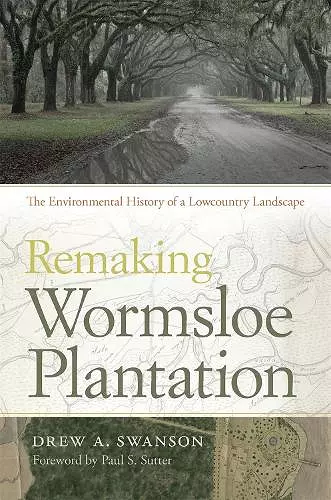Remaking Wormsloe Plantation
The Environmental History of a Lowcountry Landscape
Format:Paperback
Publisher:University of Georgia Press
Published:15th Oct '14
Currently unavailable, and unfortunately no date known when it will be back

Place and preservation at an iconic southern property
Swanson argues that while visitors to Wormsloe value what they perceive to be an "authentic," undisturbed place, this landscape is actually the product of aggressive management over generations. Remaking Wormsloe Plantation adds depth and nuance to the understanding of our own conceptions of nature and history.
Why do we preserve certain landscapes while developing others without restraint? Drew A. Swanson’s in-depth look at Wormsloe plantation, located on the salt marshes outside of Savannah, Georgia, explores that question while revealing the broad historical forces that have shaped the lowcountry South.
Wormsloe is one of the most historic and ecologically significant stretches of the Georgia coast. It has remained in the hands of one family from 1736, when Georgia’s Trustees granted it to Noble Jones, through the 1970s, when much of Wormsloe was ceded to Georgia for the creation of a state historic site. It has served as a guard post against aggression from Spanish Florida; a node in an emerging cotton economy connected to far-flung places like Lancashire and India; a retreat for pleasure and leisure; and a carefully maintained historic site and green space. Like many lowcountry places, Wormsloe is inextricably tied to regional, national, and global environments and is the product of transatlantic exchanges.
Swanson argues that while visitors to Wormsloe value what they perceive to be an “authentic,” undisturbed place, this landscape is actually the product of aggressive management over generations. He also finds that Wormsloe is an ideal place to get at hidden stories, such as African American environmental and agricultural knowledge, conceptions of health and disease, the relationship between manual labor and views of nature, and the ties between historic preservation and natural resource conservation. Remaking Wormsloe Plantation connects this distinct Georgia place to the broader world, adding depth and nuance to the understanding of our own conceptions of nature and history.
This is a really fine book, rich in the kind of detail that explains the lived-in quality of a place, deeply researched and broadly contextualized, with writing that is often graceful and a pleasure to read.
* author of “What Nature Suffers to Groe”: Life, Labor, and Landscape on the Georgia Coast, 1680–1920 *A compelling read with the plantation as the star on a stage whose supporting cast features not only the men and women who established, owned, and labored on it, reinventing it in each generation, but the processes linking it with lowcountry, Atlantic, and global arenas. Lucidly conceptualized and elegantly written, this is environmental history at its best.
* author of Spirits of the Air: Birds and American Indians in the South *Remaking Wormsloe Plantation connects this distinct Georgia place to the broader world, adding depth and nuance to the understanding of our own conception of nature and history.
* McCormick Messenger *This detailed study of Wormsloe Plantation in coastal Georgia reflects the macro-history of settlement, land development, and reinvention of the past in the coastal Deep South and, by extension, the constant and universal reinvention of the past. . . . Swanson, an authorized historian of Wormsloe, presents a history that includes all players, from humans to microbes. He reminds readers that history is never a snapshot of the past, but rather the top layer of fathomless strata of physical and psychological influences.
* Choice *More than a microhistory . . . Swanson’s story is blessed with, as he says, an interesting ‘cast’ of humans and nonhuman characters, including ‘live oaks, oysters, European and African colonists, mosquitos, viruses, government officials, hogs, chickens, historians, cotton plants, silkworms, and cattle ticks.’ The interactions of these, and the competing roles of human agents and the forces of nature, are the basis for this rich and compelling history.
* Georgia Historical Quarterly *Remaking Wormsloe Plantation connects this distinct Georgia place to the broader world, adding depth and nuance to the understanding of our own conceptions of nature and history.
ISBN: 9780820347448
Dimensions: unknown
Weight: unknown
320 pages